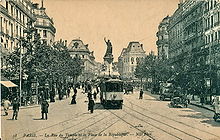
Gérard de Nerval was the pen name of the French writer, poet, and translator Gérard Labrunie, a major figure of French romanticism, best known for his novellas and poems, especially the collection Les Filles du feu, which included the novella Sylvie and the poem "El Desdichado". Through his translations, Nerval played a major role in introducing French readers to the works of German Romantic authors, including Klopstock, Schiller, Bürger and Goethe. His later work merged poetry and journalism in a fictional context and influenced Marcel Proust. His last novella, Aurélia, influenced André Breton and Surrealism.

The 2nd arrondissement of Paris is one of the 20 arrondissements of the capital city of France. In spoken French, this arrondissement is colloquially referred to as deuxième. It is governed locally together with the 1st, 3rd and 4th arrondissement, with which it forms the 1st sector of Paris.
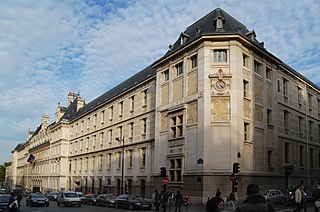
The Lycée Louis-le-Grand, also referred to simply as Louis-le-Grand or by its acronym LLG, is a public Lycée located on rue Saint-Jacques in central Paris. It was founded in the early 1560s by the Jesuits as the Collège de Clermont, was renamed in 1682 after King Louis XIV, and has remained at the apex of France's secondary education system despite its disruption in 1762 following the suppression of the Society of Jesus. It offers both a high school curriculum, and a Classes Préparatoires post-secondary-level curriculum in the sciences, business and humanities.
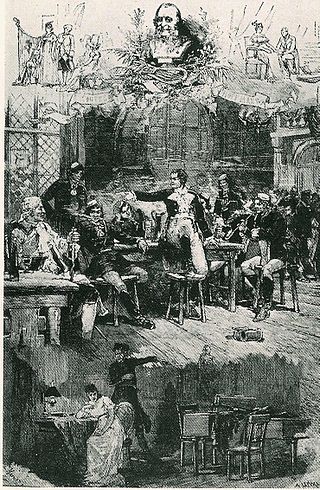
The Tales of Hoffmann is an opéra fantastique by Jacques Offenbach. The French libretto was written by Jules Barbier, based on three short stories by E. T. A. Hoffmann, who is the protagonist of the story. It was Offenbach's final work; he died in October 1880, four months before the premiere.
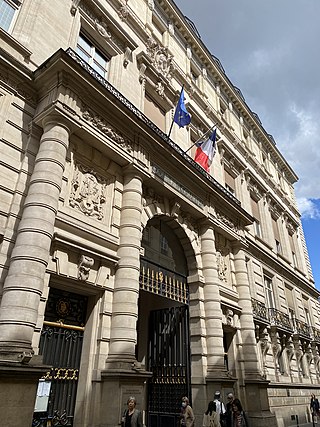
The Cour des Comptes is France's supreme audit institution, under French law an administrative court. As such, it is independent from the legislative and executive branches of the French Government. However, the 1946 and 1958 French constitutions made it the Court's duty to assist the Cabinet and Parliament in regulating government spending. The Court thus combines functions of a court of exchequer, comptroller general's office, and auditor general's office in common-law countries. It is also a Grand Corps of the French State and mainly recruits among the best-ranked students graduating from the Ecole nationale d'administration.

The Château d'Anet is a château near Dreux, in the Eure-et-Loir department in northern France, built by Philibert de l'Orme from 1547 to 1552 for Diane de Poitiers, the mistress of Henry II of France. It was built on the former château at the center of the domains of Diane's deceased husband, Louis de Brézé, seigneur d'Anet, Marshal of Normandy and Master of the Hunt.

Gabriel Nicolas de la Reynie is considered to be the founder of the first modern police force.
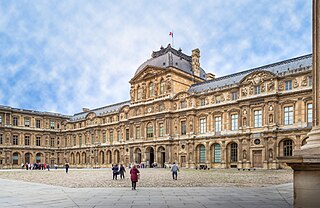
The Louvre Palace, often referred to simply as the Louvre, is an iconic French palace located on the Right Bank of the Seine in Paris, occupying a vast expanse of land between the Tuileries Gardens and the church of Saint-Germain l'Auxerrois. Originally a military facility, it has served numerous government-related functions in the past, including intermittently as a royal residence between the 14th and 18th centuries. It is now mostly used by the Louvre Museum, which first opened there in 1793.

The Ancien Régime, also known as the Old Regime, was the political and social system of the Kingdom of France from the Late Middle Ages until 1789 and the French Revolution, which abolished the feudal system of the French nobility (1790) and hereditary monarchy (1792). The Valois dynasty ruled during the Ancien Régime up until 1589 and was then replaced by the Bourbon dynasty. The term is occasionally used to refer to the similar feudal systems of the time elsewhere in Europe such as that of Switzerland.
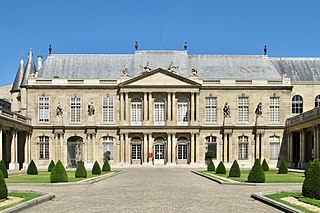
An hôtel particulier is a grand townhouse, comparable to the British townhouse or mansion. Whereas an ordinary maison (house) was built as part of a row, sharing party walls with the houses on either side and directly fronting on a street, an hôtel particulier was often free-standing and, by the 18th century, would always be located entre cour et jardin – between the cour d'honneur and the garden behind. There are hôtels particuliers in many large cities in France.

The Palais de la Cité, located on the Île de la Cité in the Seine River in the centre of Paris, is a major historic building that was the residence of the Kings of France from the sixth century until the 14th century, and has been the center of the French justice system ever since, thus often referred to as the Palais de Justice. From the 14th century until the French Revolution, it was the headquarters of the Parlement of Paris. During the Revolution it served as a courthouse and prison, where Marie Antoinette and other prisoners were held and tried by the Revolutionary Tribunal. Since the early 1800s it has been the seat of the Tribunal de grande instance de Paris, the Court of Appeal of Paris, and the Court of Cassation. The first of these moved to another Parisian location in 2018, while the other two jurisdictions remain located in the Palais de la Cité as of 2022.

The Hôtel de Beauvais is a hôtel particulier, a kind of large townhouse of France, at 68 rue Francois-Miron, 4th arrondissement, Paris. Until 1865 rue Francois-Miron formed part of the historic rue Saint Antoine and as such was part of the ceremonial route into Paris from the east. The hotel was built by the royal architect Antoine Le Pautre for Catherine Beauvais in 1657. It is an example of eclectic French baroque architecture.
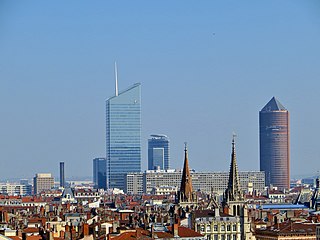
Part-Dieu is an area of Lyon Metropolis. It is also the second largest tertiary district in France, after La Défense in Greater Paris, with over 1,150,000 m2 of office and service space, along with 45,000 service sector jobs, 2,500 companies and a 97% occupancy rate. The area contains the Part-Dieu train station.

The Lescot Wing is the oldest preserved structure above ground of the Louvre Palace in Paris, France. It was designed by architect Pierre Lescot and built between 1546 and 1551. Its architecture is influenced by Italian Mannerism. It had seminal influence on what became the Parisian Renaissance style, and beyond it, French architectural classicism.

The city walls of Paris refers to the city walls that surrounded Paris, France, as it grew from ancient times until the 20th century, built primarily to defend the city but also for administrative reasons. Several successive city walls were built over the centuries, either adding to existing walls or replacing demolished ones, through 1846, when construction of the Thiers wall was completed.

The Thiers wall was the last of the defensive walls of Paris. It was an enclosure constructed between 1841 and 1846 and was proposed by the French prime minister Adolphe Thiers but was actually implemented by his successor. The 33 kilometres (21 mi) long wall and ditch made a complete circuit around the city as it stood at the time of the July Monarchy. It was bombarded by the Prussian Army during the Franco-Prussian War, captured by government troops during the Paris Commune and refortified at the start of the First World War. However, by then it had become obsolete as a fortification, was a barrier to the expansion of the city, and the area immediately outside of it, known as "the zone", had become a shanty town. The wall was demolished in the interwar period; its path today can be traced by the Boulevards of the Marshals which originally ran just behind the fortifications and by the Boulevard Périphérique which was later built just outside. A few remnants of the wall can still be seen.

The Gibbet of Montfaucon was the main gallows and gibbet of the Kings of France until the time of Louis XIII of France. It was used to execute criminals, often traitors, by hanging and to display their dead bodies as a warning to the population. It was a large structure located at the top of a small hill near the modern Place du Colonel Fabien in Paris, though during the Middle Ages it was outside the city walls and the surrounding area was mostly not built up, being occupied by institutions like the Hôpital Saint-Louis from 1607, and earlier the Convent of the Filles-Dieu, a home for 200 reformed prostitutes, and the leper colony of St Lazare.
The General Hospital of Paris was an Ancien Régime institution intended as a place of confinement of the poor. Formed by a royal edict during the reign of Louis XIV, it aimed to address the recurring problem of begging and the Cour des miracles, as well as to house invalids. The General Hospital's authority stretched beyond its premises to include all the poor in Paris.

In French law, the ministère public or le parquet is the authority charged with defending the interests of society and of the application of law. It is primarily made up of magistrates, but is sometimes represented by other persons such as police officials. Its magistrates can be referred to as "standing" magistrates, as opposed to magistrats du siège. Its closest equivalent in some English-speaking countries is the director of public prosecutions and the attorney general in others.

Criminal law in France is one of the branches of the juridical system of the French Republic. The field of criminal law is defined as a sector of French law, and is a combination of public and private law, insofar as it punishes private behavior on behalf of society as a whole. Its function is to define, categorize, prevent, and punish criminal offenses committed by a person, whether a natural person or a juridical person. In this sense it is of a punitive nature, as opposed to civil law in France, which settles disputes between individuals, or administrative law which deals with issues between individuals and government.

